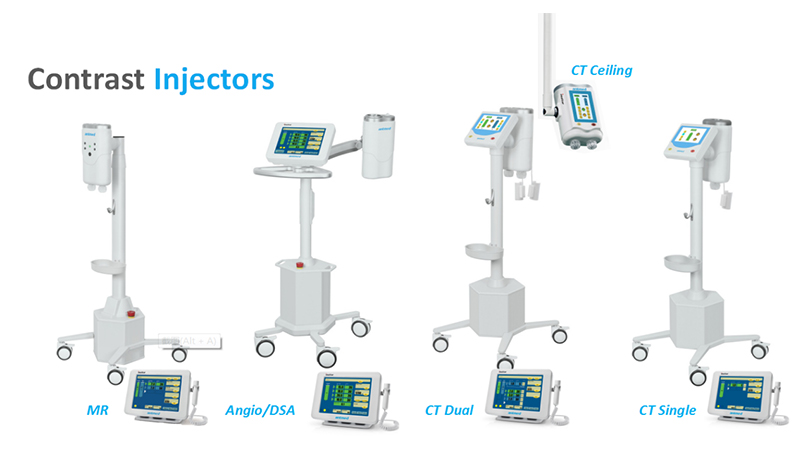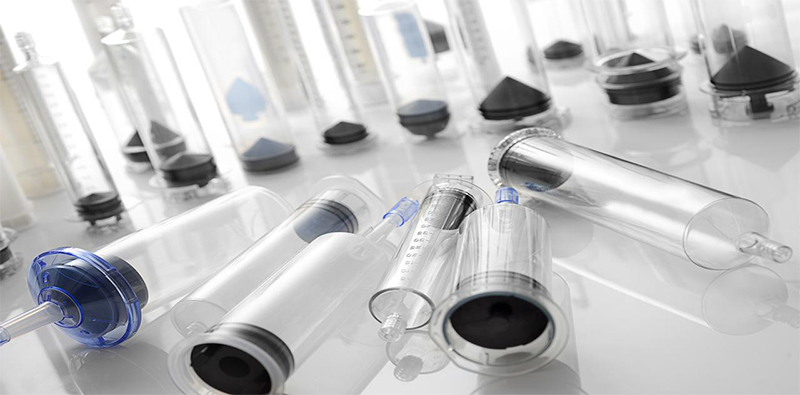As an important equipment in the medical imaging system, the Contrast Media Injector has gradually emerged with the development of X-ray machinery, rapid film changers, image intensifiers and artificial contrast medias. In the 1980s, an automatic injector for angiography appeared. Later, Jonsson et al. invented a stainless steel Contrast Media Injector using the lever principle. Soon after that, Ake Gilund of Sweden invented the first Contrast Media Injector and a two-way film changer, and applied it in angiography. Now, Contrast Media Injectors have been widely used in various angiography examinations, CT scans and MR scans.
Antmed is supplying whole range of Contrast Media Injectors, including, CT Single-head Contrast Media Injector, CT Dual-head Contrast Media Injector, MR Contrast Media Injector and Angio (DSA) Contrast Media Injector.
As the leader manufacturer in China and professional provider for Medical Imaging Industry, Antmed is also the first class supplier for the accessories of Contrast Media Injectors. We are the biggest manufacturer for High Pressure Syringes, Pressure Connecting Tubes and other products in China.
Clinical applications of Contrast Media Injector:
CT scanning:
The previous manual hand-push CT scanning cannot accurately control the injection speed of the contrast media, the injection volume is uneven, and a large injection force is required, and there are many influencing factors. Scanning is performed after the routine injection of drugs, which often results in the development of arterial phase has passed, the enhancement effect is not good, and the diagnostic requirements for various lesions cannot be met. Using a CT Contrast Media Injector in CT scanning is easy to operate, saves time and effort, and reduces the amount of contrast media; at the same time, the flow rate, flow rate and pressure can be set at one time according to the examination site, and two speeds can be used for scanning successively to maintain the contrast media concentration in the blood. In particular, it can better cooperate with multi-slice spiral CT scanning and CT angiography to display more characteristics of arteries and lesions, and provide reliable imaging basis for definite diagnosis. Moreover, the Contrast Media Injector is also equipped with an automatic heating device, which can reduce the occurrence of side reactions of the contrast media. However, due to the fast flow rate of the Contrast Media Injector liquid and the large flow rate in a short period of time, special attention should be paid to patients with severe hypertension, heart disease, and kidney disease, and the pressure and flow rate should be appropriately reduced; Toxic and side effects and contrast media spillage occurred in very few patients. In any case, the wide application of Contrast Media Injectors will certainly provide the necessary means for the advancement of CT scanning technology and imaging diagnostic methods.
MR scanning:
The magnetic resonance Contrast Media Injector is specially designed to cooperate with the magnetic resonance scanner and can work in the environment of strong magnetic field. Because the osmotic pressure of magnetic resonance contrast media is lower than that of iodine contrast media, and the total amount of contrast media required to be injected is also less, it is safe to use an MR Contrast Media Injector for enhancement. The application of the magnetic resonance Contrast Media Injector can accurately preset the enhancement site, the injection speed, the total amount of contrast sets and the delay time. Moreover, the application of Contrast Media Injector facilitates the realization of rapid breath-hold scanning.
Cardiovascular Angiography scanning:
For the angiography of the head, neck and limb arteries, liver and kidney arteries, bronchial arteries, iliac arteries and veins, when there is no high-pressure syringe, the angiography can be injected by hand push method. The disadvantage is that the operator receives more rays. However, in the angiography of the heart and aorta, especially aortic angiography and retrograde angiography, a large amount of contrast medium is required to be injected in a short period of time, so as not to be diluted by the blood, and to obtain good quality angiography, a Contrast Media Injector must be used. . The flow rate of high-pressure injection contrast media is generally required to reach 15~25ml/s, and the start switch of the syringe is linked with the X-ray camera device. A DSA Contrast Media Injector can inject a large amount of contrast media higher than the blood dilution rate in a short period of time to achieve the required concentration for imaging. Therefore, the Contrast Media Injector is one of the indispensable equipments in cardiovascular angiography. It can ensure that the contrast media is injected into the cardiovascular system of the patient in a very short time, filling the inspected part with a high concentration, so as to absorb the contrast media with better contrast imaging. The Contrast Media Injector can also coordinate the injection of the contrast media and the exposure of the host, thereby improving the accuracy of photography and the success rate of imaging. It can be remotely controlled, so that the entire staff can leave the radiology site during the shooting, improving working conditions. It is the invention and development of the Contrast Media Injector that has made great progress in the examination and treatment of interventional cardiovascular angiography.
For more information about our products and services, please contact us at info@antmed.com
Post time: Nov-01-2022



